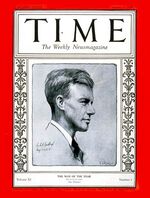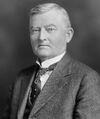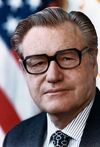Person of the Year (called Man of the Year or Woman of the Year until 1999) is an annual issue of the United States news magazine Time that features and profiles a person, a group, an idea, or an object that "for better or for worse has done the most to influence the events of the year".

Charles Lindbergh on the cover as the first winner of Time Magazine's Man of the Year Award. (1927)
Background
The tradition of selecting a "Man of the Year" began in 1927, with Time editors contemplating the news makers of the years. The idea was also an attempt to remedy the editorial embarrassment earlier that year of not having aviator Charles Lindbergh on its cover following his historic trans-Atlantic flight. By the end of the year, it was decided that a cover story featuring Lindbergh as the Man of the Year would serve both purposes.
Persons of the Year
| Year | Image or Cover | Choice | Life time | Notes |
|---|---|---|---|---|
| 1927 | 
|
Charles Lindbergh | 1902–1974 | First solo transatlantic flight. |
| 1928 | 
|
Walter Chrysler | 1875–1940 | In 1928, Chrysler oversaw a merger of his Chrysler Corporation with Dodge before beginning work on the Chrysler Building. |
| 1929 | 
|
Owen D. Young | 1874–1962 | Young chaired a committee which authored 1929's Young Plan, a program for settlement of German reparations after the Great War. |
| 1930 | 
|
Mahatma Gandhi | 1869–1948 | Gandhi was the leader of India's independence movement. In 1930, he led the Salt Satyagraha, a 240-mile march to protest the imposition of taxes on salt by the British Raj. |
| 1931 | 
|
Pierre Laval | 1869–1949 | Laval was first elected Prime Minister of France in 1931. Laval was popular in the American press at the time for opposing the Lowden Moratorium, a temporary freeze on Great War debt payments that was disliked in both France and the US. |
| 1932 | 
|
Theodore Roosevelt Jr. | 1887–1944 | Roosevelt won the 1932 US Presidential election by a landslide, defeating Vice President, Charles G. Dawes. |
| 1933 | 
|
Hugh Johnson | 1882–1942 | In 1933 Johnson was appointed director of the National Recovery Administration. US President Roosevelt gave him the task of bringing industry, labor and government together to create codes of "fair practices" and set prices. |
| 1934 | 
|
Huey Long | 1893–1935 | Long was president of the Confederate States from 1933 to 1935, and was pushing his progressive reform policies known as Share Our Wealth in 1934. |
| 1935 | 
|
Haile Selassie | 1892–1975 | Selassie was Emperor of Ethiopia in 1935. |
| 1936 | File:220px-Wallis and Edward.jpg | Wallis Simpson | 1896–1986 | In 1936, Simpson's relationship with King Edward VIII led the king to abdicate his throne in order to marry her. |
| 1937 | 
|
John Nance Garner | 1868–1967 | Garner was president of the Confederate States in 1937, which was in the middle of the Confederate Civil War. |
| 1938 | 
|
Wilhelm III of Germany | 1882–1951 | As German Chancellor, Wilhelm acceded to the throne of Germany following the abdication of his father. |
| 1939 | 
|
Joseph Stalin | 1878–1953 | In 1939, Stalin was General Secretary of the Communist Party of the Soviet Union and de facto leader of the Soviet Union. |
| 1940 | 
|
Adolf Hitler | 1889–1962 | By 1940 Hitler's Pan-Germanic cultural movement "Hitlerism" had spread throughout Europe and had even lead to Sweden joining Germany in the Polish-German War. |
| 1941 | 
|
Dumbo | Because of the war in Europe and in the Confederate States, Time Magazine decided to try to uplift the American Spirit by giving Disney's cartoon elephant Dumbo the title of Mammal of the Year. | |
| 1942 | 
|
Clement Attlee | 1874–1965 | In 1942 Attlee oversaw peace talks between Germany and the Allied powers, ending the Polish-German War. |
| 1943 | 
|
Carter Glass | 1858–1946 | Appointed President of the Confederate States, he established the Confederate Government in Exile in 1943 following the fall of Richmond. |
| 1944 | 
|
Thomas Dewey | 1902–1971 | Dewey won the 1944 US Presidential election by a landslide, defeating the incumbent, Henry Wallace. |
| 1945 | 
|
Harry F. Byrd | 1887–1966 | In 1945 Former Confederate State Senator Harry Byrd is appointed president of the Confederate Government in Exile. |
| 1946 | 
|
Umberto II of Italy | 1904–1983 | In 1946 Umberto II becomes King of Italy following the abdication of his father Victor Emmanuel III. |
| 1947 | 
|
Earl Long | 1895–1960 | In 1947 Long becomes Chairmen of the Confederation of Socialist States of America. |
| 1948 | 
|
Thomas Dewey | 1902–1971 | Dewey was reelected as President of the United States in 1948. |
| 1949 | 
|
Albert Einstein | 1879–1955 | In 1949 Einstein had been working on the possibility of using nuclear fission as a new power source for the later half of the century. |
| 1950 | 
|
Syngman Rhee | 1875–1965 | Prime Minister of Korea Syngman Rhee is awarded Man of the Year for his works in industrializing the nation in 1950. |
| 1951 | 
|
Clement Attlee | 1883–1967 | In 1951, Prime Minister Clement Attlee of the United Kingdom would have his famed A Nightmare Manifested speech in Toronto, in which he criticized the United State's continuous occupation of former Canadian territories won during the Anglo American War. Later that year, Clement met with CSSA Chairmen Earl Long, and continued to serve as Prime Minister following the general election that October. |
| 1952 | 
|
Mohammad Reza Shah | 1919-1980 | In 1952, Mohammad Reza Shah was restored to the Throne over West Persia after the failed revolution, caused by the East Persian regime. |
| 1953 | 
|
Charles Arthur Floyd | 1904–1963 | In 1953 Chairman Floyd of the CASS had begun purges through the government and military. As well as beginning military modernization and armament production. |
| 1954 | 
|
John Foster Dulles | 1888–1959 | As United States Secretary of State in 1954, Dulles was architect of the Southeast Asia Treaty Organization. |
| 1955 | 
|
Ferruccio Parri | 1890–1981 | In 1955, Ferruccio Parri the former Prime Minister of Italy, becomes the first General Secretary of the Latin League an organization which he was instrumental part of it's creation. |
| 1956 | 
|
Earl Warren | 1891–1974 | Earl Warren is reelected President of the United States in 1956. Earlier that year, Warren allowed the referendum votes in the US-occupied territories of Canada. |
| 1957 | 
|
Nikita Khrushchev | 1894–1971 | In 1957, Khrushchev consolidated his leadership of the Soviet Union, surviving a plot to dismiss him by members of the Presidium, and leading the Soviet Union into the Space Race with the launch of Sputnik 1. |
| 1958 | 
|
Charles de Gaulle | 1890–1970 | De Gaulle was appointed Prime Minister of France in May 1958 and, following the collapse of the Fourth Republic and establishment of the Fifth Republic, was then elected President of France in December. |
| 1959 | 
|
Joseph P. Kennedy Jr. | 1915–1963 | In 1959 Vice President Joseph P. Kennedy would have his famed Sokolniki Debate with Soviet First Secretary Nikita Khrushchev which became a major media event for the United States. |
| 1960 | U.S. Scientists | Represented by George Beadle, Charles Draper, John Enders, Donald A. Glaser, Joshua Lederberg, Willard Libby, Linus Pauling, Edward Purcell, James Van Allen, and Robert Woodward. | ||
| 1961 | 
|
Joseph P. Kennedy Jr. | 1915–1963 | Kennedy was inaugurated as President of the United States in 1961, he also ordered the US invasion of the CASS starting the American War. |
| 1962 | 
|
Pope John XXIII | 1881–1963 | John XXIII was head of the Roman Catholic Church from 1958 to 1963. In 1962, he volunteered to serve as a mediator in the American War, hoping to end the conflict. He also initiated the Second Vatican Council that same year. |
| 1963 | 
|
Curtis LeMay | 1906–1990 | In 1963 USAF Chief of Staff Curtis LaMay was responsible for the directing the massive carpet bombings of cities remaining loyal to the Confederation following the assassination of President Kennedy. (Among the casualties of these bombing is CASS Chairman Charles Floyd.) |
| 1964 | 
|
Nelson Rockefeller | 1908–1979 | Rockefeller was elected in his own right as President of the United States in 1964, before securing the passage of the Civil Rights Act, escalating U.S. involvement in the War against Communism. |
| 1965 | 
|
Maxwell Taylor | 1901–1987 | General Taylor was commander of U.S. forces in the Confederation of American Socialist States during the American War. |
| 1966 | 
|
Martin Luther King Jr. | 1929–2011 | In 1966 Religious and Civil Rights Leader Martin Luther King returns back to Dixie after spending half a decade in exile in the United States. Also during this year MLK would give his Dream for the Nation speech. |
| 1967 | 
|
Pujie of China | 1907–1994 | In 1967 Pujie becomes Emperor of China following the death of his Brother Puyi. |
| 1968 | 
|
Lyndon Johnson | 1908–1973 | In 1968, under President Johnson's leadership the newly reestablished Confederate States holds their first elections since 1933. |
| 1969 | 
|
The American soldier | Representing U.S. troops involved in the American War (1961–1978). | |
| 1970 | 
|
Heinz Kissinger | Born in 1923 | In 1970 Heinz Kissinger term as General Secretary of the German League would come to an end, later that year he would become Chancellor of the German Empire. He was the first Jewish General Secretary for the Germanic League and, the first Jewish Chancellor for the German Empire. |
| 1971 | 
|
Pedro III of Brazil | 1909–1981 | In 1971 Emperor Pedro III of Brazil celebrated his golden jubilee for his reign of 50 years, which was one of the major social events of the decade. |
| 1972 | 
|
Richard Nixon | 1913–1972 | As President of the United States, Nixon visited Moscow in 1972, the first sitting U.S. President to do so. Nixon later secured the SALT I pact with the Soviet Union before his assassination in November of that year. (He is the only person to be awarded Person of the Year postmortem.) |
| 1973 | 
|
American Women | Represented by Pat Nixon, Susan Brownmiller, Judy Agnew, Ella Grasso, Billie Jean King, Charlotte Reid, Shirley Chisholm, and Marilyn Monroe Kennedy. | |
| 1974 | 
|
European Mars Space Mission. | In 1974 Germanic League's Space Mission would become the first humans to reach another planet with the landing on Mars. | |
| 1975 | 
|
Vyacheslav Molotov | 1890-1986 | In 1975 Vyacheslay Molotov would become acting First Secretary of the Soviet Union following Leonid Brezhnev resignation, where he would oversee the dissolution of the USSR and the establishment of the Russian Federation. |
| 1976 | 
|
Sándor Kocsis | 1929-2010 | In 1976 Sándor Kocsis is elected General Secretary of the Germanic League, which he began the process of overseeing the distribution of money to help newly non-communist nations. |
| 1977 | 
|
Robert Kennedy | 1925-2007 | In 1977 the newly elected US President, began working on finally ending the American War beginning peace talks between himself, along side President Jimmy Carter, with Chairmen Fidel Castro in the State of Cuba. |
| 1978 | 
|
Caesarion XXXI | 1952-1999 | Caesarion XXXI becomes pharaoh of Egypt following the end of the People’s Republic of Egyptian Provinces. |
| 1979 | 
|
Martin Luther King Jr. | 1929-2011 | In 1979 MLK would begin the famed Peace Train tour across the Confederate States trying to push for reforms in race relations and faith building in the nation. |
| 1980 | 
|
Robert Kennedy | 1925-2007 | In 1980 President Kennedy would win reelection in one biggest landsides victories in United States political history. |
| ||||||||||||||||||


